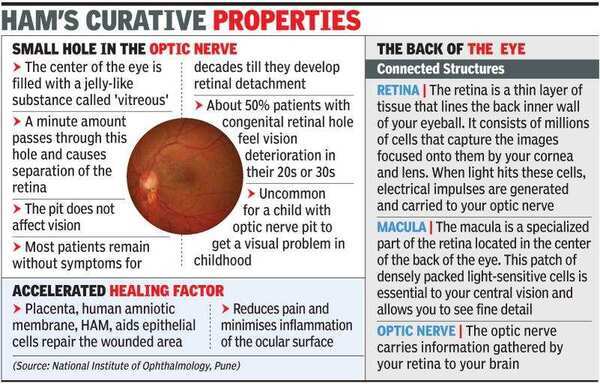Trending
This story is from June 27, 2020
Graft from cryopreserved placenta restores partial vision to 13-yr-old
Almost a year after Italian doctor Stanislao Rizzo used a woman's cryopreserved placenta to repair a recurrent retinal hole, Pune-based eye surgeon Aditya Kelkar applied the same approach to treat a 13-year-old-girl's optic nerve pit.

Representative image
PUNE: Almost a year after Italian doctor Stanislao Rizzo used a woman's cryopreserved placenta to repair a recurrent retinal hole, Pune-based eye surgeon Aditya Kelkar applied the same approach to treat a 13-year-old-girl's optic nerve pit.

She was losing her left eye vision due to a tiny hole in the optic nerve, a congenital anomaly. The teen has regained partial vision after the surgery and her parents said she has resumed online studies.
The hole was filled using a 3mm tissue drawn from the innermost part of a placenta or the human amniotic membrane.The graft was sourced from an Aurangabad-based firm that deals with cryopreserved placenta.
In India, about 1 in 10,000 individuals suffer from a retinal pit, either at birth or due to trauma. Such eye pits are unlikely to have a permanent closure and treatments offer temporary relief.
Kelkar performed the complex surgery mid-March. “The success rate of treatment in such cases is 75% in young adults. It recurs in 25% cases. The condition is rare among those under 15 years of age,” he added
He used the tiny keyhole approach to implant the microsized placental tissue and the intraoperative optical coherence tomography, a high-end scan machine, for the exact positioning of the graft in the hole.
“The graft sealed the girl's optic nerve pit. Once the fluid collection under the retina stopped, her vision improved rapidly,” Kelkar said.
The placenta is sticky which makes the graft placement tricky, but the vitrectomy equipment and the 3-D surgery technique made it safer and allowed faster visual rehab, Kelkar said.
Retina surgeon Shobhit Chawla, president of the Retina Society of India said eye surgeons have used placental graft to treat retinal holes in the past.
“This is perhaps the first time in India that an eye surgeon has used the method to fix a rare congenital optic nerve pit in a teen,” he added.

She was losing her left eye vision due to a tiny hole in the optic nerve, a congenital anomaly. The teen has regained partial vision after the surgery and her parents said she has resumed online studies.
The hole was filled using a 3mm tissue drawn from the innermost part of a placenta or the human amniotic membrane.The graft was sourced from an Aurangabad-based firm that deals with cryopreserved placenta.
“The novel approach has been used for the first time in India to treat the rare congenital eye defect, a recurrent hole in the optic nerve of the girl's retina, the most delicate part of the eye,” Kelkar, director of the National Institute of Ophthalmology, told TOI.
In India, about 1 in 10,000 individuals suffer from a retinal pit, either at birth or due to trauma. Such eye pits are unlikely to have a permanent closure and treatments offer temporary relief.
Kelkar performed the complex surgery mid-March. “The success rate of treatment in such cases is 75% in young adults. It recurs in 25% cases. The condition is rare among those under 15 years of age,” he added
He used the tiny keyhole approach to implant the microsized placental tissue and the intraoperative optical coherence tomography, a high-end scan machine, for the exact positioning of the graft in the hole.
“The graft sealed the girl's optic nerve pit. Once the fluid collection under the retina stopped, her vision improved rapidly,” Kelkar said.
The placenta is sticky which makes the graft placement tricky, but the vitrectomy equipment and the 3-D surgery technique made it safer and allowed faster visual rehab, Kelkar said.
Retina surgeon Shobhit Chawla, president of the Retina Society of India said eye surgeons have used placental graft to treat retinal holes in the past.
“This is perhaps the first time in India that an eye surgeon has used the method to fix a rare congenital optic nerve pit in a teen,” he added.
End of Article
FOLLOW US ON SOCIAL MEDIA










